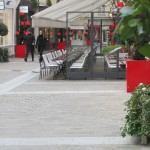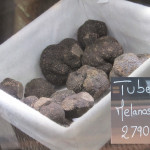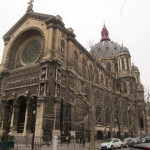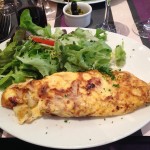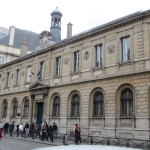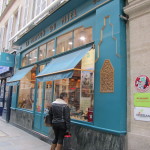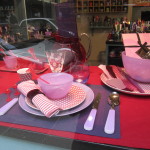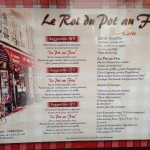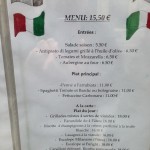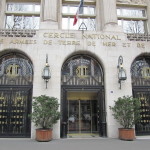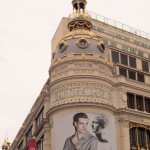Todays Cheese: http://thelittersitter.com/?_escaped_fragment_=policies/cxd1 Comté
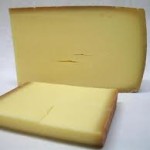
Comté is a French cheese made from unpasteurized cow’s milk in the Franche-Comté region of eastern France. Comté has the highest production of all French AOC cheeses, around 40,000 tonnes annually.
About Comté: Comté is an ancient cheese. It has been produced since the time of Charlemagne. Comté is still traditionally made in more than 190 cheese dairies, known as the “fruitières” in the Jura plateau.
Comté making: Cheesemakers need about 530 liters of milk – the daily production of 30 cows – to make one Comté, weighing approximately 35 kilos (80 pounds). Morning and evening milks from Montbeliarde and Tachete de L’est cows are mixed. Comté requires a long maturing period called affinage. The cheese is regularly cleaned and rubbed with salted water. The eyes – holes – of the Comté are the result of a correct affinage and should be the size of a pea to a small cherry.
Tasting Comté: Comté has an ivory-colored paste scattered of holes the size of a hazelnut. Comté has a complex, nutty and caramelized flavor.
Tasting advice: As an appetizer, Comté is perfect cut into small cubes. Comté is a traditional fondue cheese. Comté can also be grated, chunked or melted.
Comté and wine: Dry white wines such as Sancerre, light red wine such as Beaujolais, Jura yellow wine
Tasters note: We prefer the more aged cheese of 24-mos to 36-mos where the cheese forms crystals, similar to cheddar. Â this is one of my favorite cheeses to substitute in pizza for mozzarella.
Now for today’s activities! Up and out, but it’s an overall grey blustery day with rain forecast for later in afternoon. We had selected a walk from one of Alex’s books, an On Foot Guide called buy prednisone 20 mg Paris Walks. It covers an area we have walked before but it is fun to view the known though someone else’s words. So we’re “Putting on the Ritz: Around the Grands Boulevards” beginning at Place de la Concorde. Up Rue Royale, laid out in the early 18th century. During the Belle Epoque, it became the height of fashion and remains so today with Christofle, Bernardoud, and, of course, the landmark restaurant Maxim’s. The house where Maxim’s is located was owned by Cardinal Richelieu, Louis XIII’s Chief Minister. Naturally, Rue Royale is home to famed LaDuree’s tea room and home of the macaron!
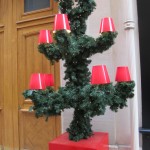
One of the decorated trees in Le Village Royale. The red shades on the tree are actually plastic pots. Mike thinks he could make this tree…..
We cut over to an alleyway (wish Richmond’s alleys looked like this) called Le Village Royal, an uncovered passageway with an enclave of cafes and boutiques surrounded by immaculately maintained buildings. The passageway was still decorated for Christmas with lighted pre-formed trees covered with light shades! Very cute idea!
To get back to Place Madeleine, we cut through Galerie de Madeleine another gallery, this one covered, with Yves de Lorme stores but not much else. On the corner we found Lucas-Carton, the restaurant of Alain Senderens. Not much to see from the outside, but elegant curtains and a sort of deco-inspired exterior. In the center, dominating the square is the church of Ste-Marie Madeleine. Designed to look like a Roman temple with a Corinthian colonnade; at one stage, it was destined to be a bank, but was finally consecrated as a church in 1842. There’s a concert scheduled here on St-Valentin’s Day – the best way to experience the church.
Place Madeleine is home to the highly decorative art nouveau public conveniences installed by Porcher with tiles, satined glass, and polished mahogany. However, they were closed today, but we had seen them on a previous visit. We strolled through the flower market there – comparing prices of tulips to those near us. They were more expensive at Madeleine! The Place is home to Caviar Caspia, La Maison de Truffe, Hediard, and Fauchon. The spot for gourmets.
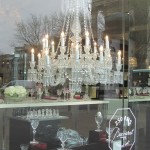
A lovely, huge, magnificent crystal chandelier in the window of the Baccarat store
We left empty handed and headed up boulevard Malesherbes, past the wonderful chandeliers in the window at Baccarat, toward St Augustin, a Second Empire church. The vista up this street is very Parisian with opulent houses lining the boulevard. Â Just in front of the church is a statue of Jeanne d’Arc by Paul Dubois.
We stopped for lunch nearby at Le Saint-Augustin Brasserie and Cafe. Omelets and salads for us both. After lunch we wandered toward Rue du Havre to catch a glimpse of Lycée Condorcet. The Lycée started out in 1780 as a Capuchin monastery designed by Brongniart (architect of the Bourse), was converted for a spell to a hospital, and is now a school. Many of Paris’ rich and famous studied here from Haussmann to Proust.
Off again to check out the interesting architecture of Paul, a Viennese bakery established in 1889 at 55 Boulevard Haussmann. We had just eaten lunch so we passed on a sandwich or a dessert.
On to square Louis XVI, a garden with lots of green. But its past is pretty grisly, this is actually the site of Madeleine cemetery where thousands of guillotine victims were buried. The remains of Louis XVI and Marie Antoinette were brought here after their executions. When Louis XVIII came to the throne, he had their remains removed to the Basilica of St Denis and commissioned the Chapelle Expiatoire here in their memory. It was closed, is only open Thursday through Saturday afternoons. The courtyard tombs are in memory of the Swiss guards killed in the Tuileries attack (1792).
Down rue Vignon we found La Maison du Meil with varieties of honey including thyme, lavender, and eucalyptus – to name a few. Â During our walk, we found two new potential restaurants to try: an Italian one with fresh, house made pasta and a traditional French restaurant specializing in pot au feu. Stay tuned to see if we try them and report back.
We walked down to Place de la Concorde, caught the 52 bus toward Pte St-Cloud. We hadn’t taken this bus before, but at some point, it stops one half block from where we are renting. It takes a round about route: Rue du Faubourg, Rue de Miromesnil, Rue Boetie, Rue du Faubourg, Boulevard Friedland, to the Arc de Triomphe, to Avenue Victor Hugo, to Rue de la Pompe, to our bus stop. On the way, we get to peer in the windows of boutiques, shops, and get a feel for the neighborhoods we pass.
The kinds of things we love to see and be inspired by during our walks!
After we rest up Рmoules and frites tonight! Were headed to Le bon P̻cheurs over by the old Les Halles Market/Mall, now be reinvented. Moules and frites were a great value, they still cut the frites in a v-shape so they get extra crispy on more of the surface. But, not much progress on Les Halles, we think they are being overly optimistic on their completion date!


